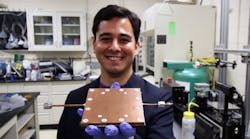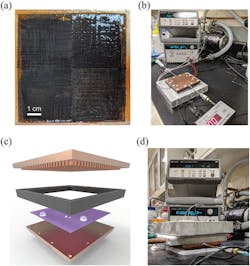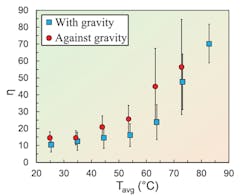What you'll learn:
- How a Virginia Tech research team constructed its novel thermal diode.
- Test results of the thermal diode.
Electrical engineers are obviously very familiar and comfortable with the basic diode, a passive and vital component that restricts current flow to one direction only, while mechanical engineers have their corresponding check valves that perform a similar function for fluid flow. Yet regardless of discipline, all engineers are familiar with the basics of thermodynamics. which show heat will always flow from a warmer body to a cooler one, without some sort of active heat pump.
It would be nice to have an analog to those electronic and fluid diodes in the form of a thermal diode that, in principle, would have high thermal resistance in one direction but low resistance in the other direction. Such restricted, unidirectional heat flow would be useful for “dumping” of heat entering one side while resisting heat on the opposite side. (Note: In electronics, the term “thermal diode” refers to an electrical diode that’s used as a basic temperature sensor, which a very different function.)
Some background: Such an arrangement does exist, but to a very limited extent, and the concept and construction of thermal diodes isn’t new development. According to Wikipedia (with credible supporting citations), the effect was first observed in a copper/cuprous-oxide interface by Chauncey Starr at Rensselaer Polytechnic Institute in the 1930s. Theoretical models were proposed beginning in 2002 to explain this effect, and in 2006 the first microscopic solid-state thermal diodes were built (Physics World, "Phononics gets hot"). In 2015, Italian researchers announced development of a working thermal diode, publishing their results as “Rectification of electronic heat current by a hybrid thermal diode” in Nature Nanotechnology (behind a paywall but also posted here).
Now, a team led by Jonathan Boreyko, associate professor in mechanical engineering at the Virginia Polytechnic Institute (better known as Virginia Tech) , has developed a thermal diode targeting aircraft thermal-management technology, but which may be adaptable to other areas including electronic-component and package cooling.
Their approach uses two parallel copper plates separated by an insulating gasket just micrometers thick; one plate contains a superhydrophilic wick structure while the other is smooth and hydrophobic (Fig. 1). The surface of the first plate has a wick-like structure consisting of micropillars that hold and conduct water, while the second parallel plate is smooth and coated with a hydrophobic water-repelling layer.
In the diode’s “forward” mode (analogous to conducting), water on the wicking plate absorbs heat from its surroundings and evaporates into steam. This steam then propagates across the narrow gap between the plate and condenses into dew-like droplets on the hydrophobic plate. When the droplets grow large enough to bridge the gap, they get sucked back into the wick structure, starting the process anew. The large contact angle of the dropwise condensate enables bridging across the gap to replenish the wicked evaporator, providing sustained phase‐change heat transfer.
Conversely, in the reverse non-conducting mode, the heat source is now on the hydrophobic plate, resulting in dryout and excellent thermal insulation across the gap. No steam is produced because the water remains trapped in the wick; thus, the device can only conduct heat in one direction. The hydrophobic, nonconducting side prevents heat from entering via the air or other heat sources that may be near, while allowing the diode to manage the heat only from its main subject.
The experimental arrangement was designed to provide support as well as enable thermal and other tests (Fig. 2).
The heat-transfer ratio of this thermal diode is fairly independent of orientation, making it suitable for applications including space-related cooling. The team reported a forward-backward (front-to-back) heat-transfer ratio—which they called “diodicity”—of 85 (that’s a direct ratio, not dB) (Fig. 3). Present thermal diodes either aren’t very effective or only conduct a few times more heat in the forward direction than the reverse. Further, unlike this approach, they require gravity to function.
Boreyko notes that the water-repellent coating he and his colleagues used in their test device (a mixture of 1-hexadecanethiol in ethanol) isn't suitable for practical applications. However, he says this coating could be replaced with more durable alternatives such as graphene or grafted polymers. He noted, “we are hopeful that the one-way heat transfer of our bridging-droplet diode will enable the smart thermal management of electronics, aircraft, and spacecraft.”
The team would also like to increase diodicity of their device to 100. This could be possibly be done by decreasing the height of the micropillars so that smaller droplets could bridge the insulating gap between the two copper plates. The researchers would also like to test more durable hydrophobic coatings.
Full detail of the work, including materials, configuration, thermal-physics analysis, and equations, and additional test results are available in their paper with the deceptively short title “Bridging-Droplet Thermal Diodes” published in Advanced Functional Materials. (While that paper is behind a paywall, it’s also available here; click and then scroll down.) The team has filed a provisional patent and is in search of industry partners to carry on the work.



